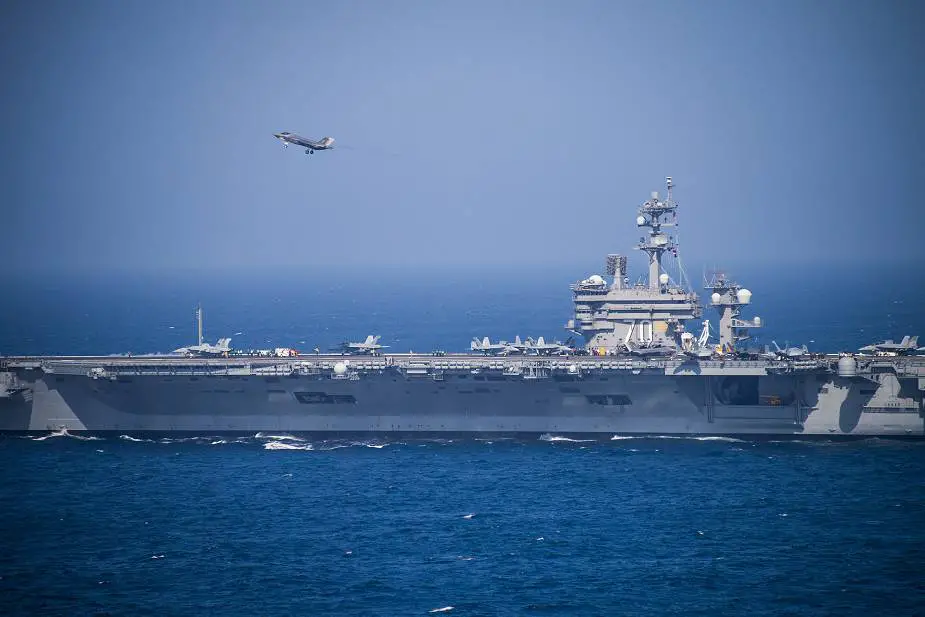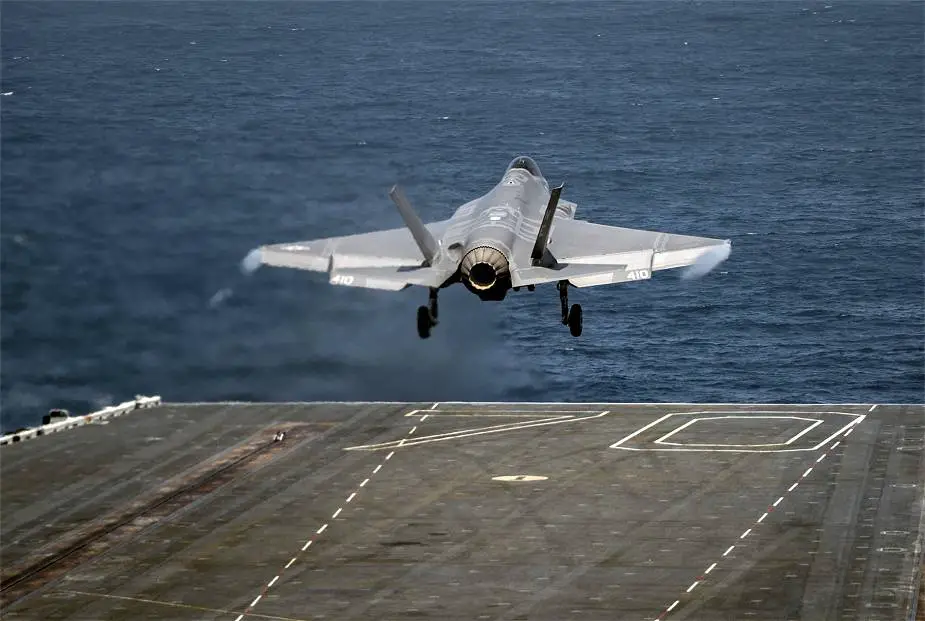Breaking news
US Navy USS Carl Vinson CVN 70 aircraft carrier completes flight deck certification with F-35C fighter aircraft.
According to a press release published by Commander, U.S. Pacific Fleet website, the U.S. Navy USS Carl Vinson (CVN 70) Nimitz-class aircraft carrier successfully completed several certifications, including flight deck certification (FDC) and carrier air traffic control center (CATCC) certification, Sept. 17, after nearly a week of flight deck operations designed to ready the carrier for future operations.
Follow Navy Recognition on Google News at this link
 An F-35C Lightning II from the “Argonauts” of Strike Fighter Squadron (VFA) 147 demonstrates a flyby above the flight deck of Nimitz-class nuclear aircraft carrier USS Carl Vinson CVN 70. (Picture source Flickr account U.S. Pacific Fleet)
An F-35C Lightning II from the “Argonauts” of Strike Fighter Squadron (VFA) 147 demonstrates a flyby above the flight deck of Nimitz-class nuclear aircraft carrier USS Carl Vinson CVN 70. (Picture source Flickr account U.S. Pacific Fleet)
The underway also marked the first time that Carrier Air Wing (CVW) 2 and Vinson, both part of Carrier Strike Group (CSG) 1, fully integrated and operated together since the addition of the F-35C Lightning II.
FDC (Flight Deck Certification) is required for the carrier to embark aircraft, the primary weapons system for the platform, and is designed to provide operational continuity and proficiency training for carrier crews. During FDC, the carrier is evaluated on its ability to launch and recover aircraft in a safe manner in both day and night time operations.
Vinson, along with CVW-2 squadrons, also achieved certification in precision approach landing systems (PALS), joint precision approach landing systems (JPALS) and carrier qualifications for the six fixed-wing squadrons.
Prior to integrated operations with the air wing, Vinson underwent a 17-month maintenance availability to receive major upgrades in support of 5th generation aircraft, making Vinson the first aircraft carrier equipped to support both the F-35C Lightning II and CMV-22 Osprey. Upgrades included enhanced jet blast deflectors able to take the increased heat generated by the F-35C and the addition of the Autonomic Logistics Information System (ALIS), the new computer network that supports the unique maintenance and tactical operations functions of the advanced aircraft.
With its recent modifications, no other weapons system has the responsiveness, endurance, multi-dimensional might, inherent battlespace awareness or command and control capabilities of the Vinson and CVW-2.
Other components of the air wing include three U.S. Navy Strike Fighter Squadrons (VFA) that fly the F/A-18E/F Super Hornet, one Electronic Attack Squadron (VAQ) that operates the EA-18G Growler, Carrier Airborne Early Warning Squadron (VAW) that operates the E-2D Hawkeye, one Helicopter Maritime Strike Squadron (HSM) and one Helicopter Sea Combat Squadron (HSC). Through multiplatform integration, CVW-2 will provide fleet commanders the ability to achieve the advantage across multiple domains: air, land, sea and electromagnetic.
Integration between the air wing and ship’s company is crucial to the everyday success of carrier operations. These flight operations take detailed coordination between ship's company and the air wing squadrons, and flight deck certification was an opportunity to build that relationship.

An F-35C Lightning II from the “Argonauts” of Strike Fighter Squadron (VFA) 147 takes off from the flight deck of Nimitz-class nuclear aircraft carrier USS Carl Vinson CVN 70. (Picture source Flickr account U.S. Pacific Fleet)
The USS Carl Vinson (CVN-70) is the United States Navy's third Nimitz-class supercarrier. The keel was laid at Newport News Shipbuilding on 11 October 1975, and on 15 March 1980 the ship was launched and christened. The refueling and overhaul were conducted between 2005 and 2009. The USS Carl Vinson can carry more than 65 fixed and rotary-wing aircraft and can travel more than 5,000 nautical miles in less than seven days in support of national tasking.
Carrier Air Wing Two (CVW-2) is a United States Navy aircraft carrier air wing based at Naval Air Station Lemoore. The air wing is attached to the aircraft carrier USS Carl Vinson (CVN-70). The CVW-2 consists of 9 Squadrons including Strike Fighter Squadron 2 with F/A-18F Super Hornet fighter, Strike Fighter Squadron 113 with F/A-18E Super Hornet fighter, Strike Fighter Squadron 147 with F-35C Lightning II naval variant of stealth fighter F-35, Strike Fighter Squadron 192 with F/A-18E Super Hornet fighter, Carrier Airborne Early Warning Squadron 113 with E-2C Hawkeye carrier-capable tactical airborne early warning (AEW) aircraft, Electronic Attack Squadron 136 with EA-18G Growler carrier-based electronic warfare aircraft, Fleet Logistics Support Squadron 30 with C-2A Greyhound high-wing cargo aircraft, Helicopter Sea Combat Squadron 4 with MH-60S Seahawk naval helicopters and Helicopter Maritime Strike Squadron 78 with MH-60R Seahawk naval helicopters.
The F-35C variant is designed for catapult-assisted take-off but arrested recovery operations from aircraft carriers. Compared to the F-35A, the F-35C features larger wings with foldable wingtip sections, larger wing and tail control surfaces for improved low-speed control, stronger landing gear for the stresses of carrier arrested landings, a twin-wheel nose gear, and a stronger tailhook for use with carrier arrestor cables. The larger wing area allows for decreased landing speed while increasing both range and payload.





























